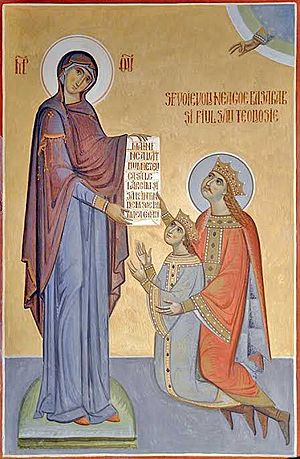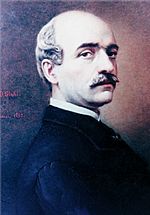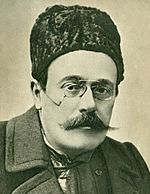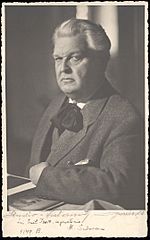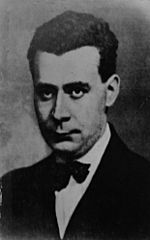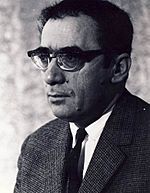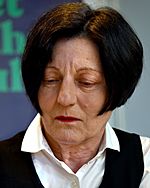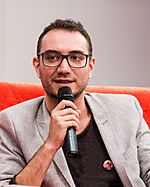Romanian literature facts for kids
Romanian literature (Romanian: Literatura română) is writing created by Romanian authors. It can also mean all literature written in the Romanian language or by any authors from Romania.
Contents
History of Romanian Writing
Romanian literature grew alongside a rich Romanian folklore. This includes songs, stories, and poems passed down through generations. This oral tradition is still important today.
Romanian oral literature features:
- Doine (lyric songs)
- Balade (ballads)
- Hore (dance songs)
- Colinde (carols)
- Basme (fairy tales)
- Snoave (anecdotes)
- Vorbe (proverbs)
- Ghicitori (riddles)
Early Slavonic Writings
The Old Church Slavonic script was used in the lands of modern-day Romania as early as the 10th century. The oldest surviving writings are from the 12th century. Early Slavonic texts from Wallachia and Moldavia include religious songs and a text about saints. These date back to the late 1300s. By the 15th century, many copies of medieval Slavonic texts were made by scribes in these areas.
Many translated medieval adventure stories were also popular. These included tales like the Alexander Romance and Barlaam and Josaphat.
A very important work is "The Teachings of Neagoe Basarab to his son Theodosie." This book, written around 1519-1521, offers advice on morals and politics. It was written by Neagoe Basarab, a ruler of Wallachia. This work is seen as one of the first great pieces of literature in South-Eastern Europe from the Renaissance period.
First Romanian Books
The oldest surviving document written in Romanian is Neacșu's Letter. It was written in 1521 to the mayor of Brașov, Hans Benkner.
The first books in Romanian were translations of Slavonic religious texts. These appeared in the 15th century. Examples include the Psalter of Șchei (1482) and the Voroneț Codex.
The first book printed in the Romanian lands was a Slavonic religious book in 1508. It was printed at Dealu Monastery. The very first book printed in the Romanian language was a Protestant catechism by Deacon Coresi in 1559. Many other translations from Greek and Slavonic followed in the 16th century. In 1673, Dosoftei, a Moldavian Bishop, published the first Romanian book of poems.
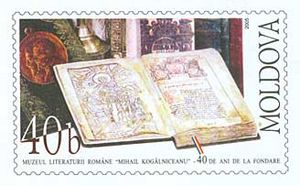
Early efforts to print the Bible in Romanian began in 1582. The Palia de la Orăștie was printed in Orăștie. This book contained translations of the first books of the Old Testament. It was translated from Latin and checked against Hungarian Bible translations.
The complete Bible in Romanian was not published until 1688. This was the "Biblia de la București" compiled by the Greceanu Brothers.
In Transylvania, the first Romanian dictionary appeared around 1650. It was called Dictionarium Valachico-Latinum. The first grammar book for the Romanian language was written in Latin around 1770.
Humanism in Romanian Lands
Humanism first appeared in Moldavia and Wallachia in the 16th century. Important figures included Luca Stroici and Petru Cercel. However, it took another century for humanism to fully develop there. This might be because the Romanian lands had strong ties to Byzantine culture.
During the 17th century, humanism grew through Poland and its Jesuit Schools. Key writers like Grigore Ureche, Miron Costin, and Ion Neculce wrote chronicles about the history of Moldavia. Following the example of schools in Kyiv, rulers Matei Basarab and Vasile Lupu set up Neoclassical schools.
The most important Romanian Humanist was Dimitrie Cantemir. He wrote histories of Wallachia, Moldavia, and the Ottoman Empire. He also wrote philosophical and religious books. In 1705, he wrote "A Hieroglyphic History," a novel where characters are disguised.
National Awakening and Modern Literature
As ideas of nationalism spread in Europe, Romanians also wanted their own country. Many writers joined this national movement. They took part in the revolutions of 1821 and 1848. People began discussing the Origin of the Romanians. In Transylvania, a group called Școala Ardeleană studied the Roman origins of the Romanian language. They also opened Romanian language schools.
Romanians studied in France, Italy, and Germany. German philosophy and French culture became part of modern Romanian literature. This slowly reduced the influence of Ancient Greece and the Orient. In Wallachia, Ion Heliade Rădulescu was a key figure. He started the first Romanian-language newspaper and the Philharmonic Society. This society later created the National Theatre of Bucharest.
The most important writers of the second half of the 19th century were Vasile Alecsandri and later Mihai Eminescu. Alecsandri wrote a lot of poetry, prose, plays, and collected Romanian folklore. Eminescu is seen as the most important Romanian poet. His poems were inspired by Romanian traditions, German philosophy, and Hindu ideas.
The Junimea literary group, started by Titu Maiorescu in 1863, was very important. Many Romanian writers met there. Famous writers like Ion Luca Caragiale, who wrote great comedies, and Ion Creangă, who wrote traditional Romanian stories, published their works during this time. George Coșbuc was a poet known for describing rural life. Many other writers also contributed to literature during this period.
Literature Between the World Wars
After Romania became united in 1918, Romanian literature entered a "golden age." This period saw the growth of the Romanian novel. Traditional society and recent political events influenced many works. For example, Liviu Rebreanu's Răscoala ("The Uprising," 1932) was inspired by the 1907 Romanian Peasants' Revolt. His book Pădurea Spânzuraților ("Forest of the Hanged", 1922) was about Romanians in World War I.
Modern novels began with writers like Hortensia Papadat-Bengescu (Concert din muzică de Bach) and Camil Petrescu (Ultima noapte de dragoste, întâia noapte de război). George Călinescu was a complex writer. He was a novelist, playwright, poet, critic, and historian. He wrote important books about Eminescu and Creangă. He also wrote a huge history of Romanian literature.
Mihail Sadoveanu was an important realist writer. He mainly wrote novels set in different times in Moldova's history. But perhaps the most important writers were Tudor Arghezi, Lucian Blaga, and Mircea Eliade. Arghezi changed Romanian poetry 50 years after Eminescu. Blaga developed a complex philosophical system through his writings. Eliade is known as a great historian of religions. His novels show mystical, pre-Christian ideas.
Tristan Tzara, born in Romania, was a poet and essayist. He was a main founder of Dada, a revolutionary art movement. He later moved from Dada to Surrealism and Marxism. For the first time, Romanian culture was fully connected to Western culture. Dadaism was the first Romanian art movement to become international. Dadaism and Surrealism are key parts of the avant-garde, a very revolutionary form of modernism.
Other important writers of this time include George Bacovia, a symbolist poet. His poetry later became a start for Romanian Modernism. Some writers were also active in other fields. Vasile Voiculescu was a poet and a physician. Ion Barbu was a poet and an important mathematician.
Cezar Petrescu was a journalist, novelist, and children's writer. He is remembered for his children's book Fram, ursul polar ("Fram, the polar bear"). Elena Farago also wrote for children.
Ion Agârbiceanu was a writer, politician, and priest. Gala Galaction was another writer who was also an Eastern Orthodox clergyman.
Other literary figures from this time include Ionel Teodoreanu, Panait Istrati, Gib Mihăescu, Otilia Cazimir, and George Topîrceanu.
Literature During the Communist Era
Marin Preda is often seen as the most important Romanian novelist after World War II. His novel, Moromeții ("The Moromete Family"), describes the life of a peasant family before and during the start of Communism in Romania. His most important book is Cel mai iubit dintre pământeni ("The Most Beloved of Earthlings"). This book gives a harsh look at communist society. Zaharia Stancu published his first important novel, Desculț (Barefoot), in 1948.
Some of the most important poets of this time are Nichita Stănescu, Marin Sorescu, Ana Blandiana, Leonid Dimov, and Ștefan Augustin Doinaș. Radu Tudoran was an important novelist.
Outside Romania, Eugène Ionesco and Emil Cioran became very famous. Ionesco is a leading playwright of the Theatre of the Absurd. His plays show how lonely people can feel and how small one's life can seem. Cioran was a writer and philosopher.
Contemporary Romanian Literature
Here are some Romanian writers from today:
- Gabriela Adameșteanu
- Ștefan Agopian
- Radu Aldulescu
- Nicolae Breban
- Svetlana Cârstean
- Mircea Cărtărescu
- Traian T. Coșovei
- Gheorghe Crăciun
- Alexandru Ecovoiu
- Radu Pavel Gheo
- Ioan Groșan
- Florin Iaru
- Claudiu Komartin
- Ion Bogdan Lefter
- Norman Manea
- Dan C. Mihăilescu
- Grid Modorcea
- Herta Müller (2009 Nobel Laureate)
- Ion Mureșan
- Mircea Nedelciu
- Ioana Pârvulescu
- Dora Pavel
- Dumitru Radu Popescu
- Simona Popescu
- Sorin Preda
- Doina Ruști
- Tudor Dumitru Savu
- Dan Sociu
- Cecilia Ștefănescu
- Ion Stratan
- Bogdan Suceavă
- Cristian Teodorescu
- Dumitru Țepeneag
Timeline of Romanian Literature: 19th Century to Today
- 1812 Țiganiada – Ioan Budai-Deleanu (epic poem)
- 1847 Povestea vorbii – Anton Pann (narrative poem)
- 1850 Cântarea României – Alecu Russo (epic poetry)
- 1857 Alexandru Lăpușneanul – Costache Negruzzi (historical novel)
- 1861-1863, posthumously Românii supt Mihai-Voievod Viteazul – Nicolae Bălcescu (historical non-fiction)
- 1867 Răzvan și Vidra – Bogdan Petriceicu Hasdeu (play)
- 1879 Amintiri din copilărie – Ion Creangă (autobiographical novel)
- 1883 Poezii – Mihai Eminescu (poetry)
- 1884 O Scrisoare Pierdută – I.L. Caragiale (play)
- 1894 Mara – Ioan Slavici (novel)
- 1920 Ion – Liviu Rebreanu (novel)
- 1924 În Marea Trecere – Lucian Blaga (poetry)
- 1925 Danton – Camil Petrescu (play)
- 1927 Concert din Muzică de Bach – Hortensia Papadat-Bengescu (novel)
- 1927 Cuvinte Potrivite – Tudor Arghezi (poetry)
- 1929 Craii de Curtea-Veche – Mateiu Caragiale (novel)
- 1930 Joc Secund – Ion Barbu (poetry)
- 1933 Patul lui Procust – Camil Petrescu (novel)
- 1934 Ioana – Anton Holban (novel)
- 1936 Întâmplări în Irealitate Imediată – Max Blecher (novel)
- 1938 Enigma Otiliei – George Călinescu (novel)
- 1943 Panopticum – Ion Caraion (poetry)
- 1945 Plantații – Constant Tonegaru (poetry)
- 1946 Stanțe Burgheze – George Bacovia (poetry)
- 1946 Libertatea de a Trage cu Pușca – Geo Dumitrescu (poetry)
- 1947 Don Juana – Radu Stanca (play)
- 1955 Moromeții – Marin Preda (novel)
- 1956 Primele Iubiri – Nicolae Labiș (poetry)
- 1964 Ultimele sonete închipuite ale lui Shakespeare – Vasile Voiculescu (poetry)
- 1965 Iarna Bărbaților – Ștefan Bănulescu (short prose)
- 1966 Omul cu Compasul – Ștefan Augustin Doinaș (poetry)
- 1966 11 Elegii – Nichita Stănescu (poetry)
- 1968 Iona – Marin Sorescu (play)
- 1969 Carte de Vise – Leonid Dimov (poetry)
- 1969 Dicționar onomastic – Mircea Horia Simionescu (novel)
- 1970 Matei Iliescu – Radu Petrescu (novel)
- 1973 Vânătoarea Regală – Dumitru Radu Popescu (novel)
- 1975 Lumea în Două Zile – George Bălăiță (novel)
- 1977 Cartea de la Metropolis – Ștefan Bănulescu (novel)
- 1977 Bunavestire – Nicolae Breban (novel)
- 1980 Faruri, Vitrine, Fotografii – Mircea Cărtărescu (poetry)
- 1983 Dimineață Pierdută – Gabriela Adameșteanu (novel)
- 1983 Poeme de Amor – Mircea Cărtărescu (poetry)
- 1988 versuri vechi, nouă – Mircea Ivănescu (poetry)
- 1989 Și Ieri Va Fi o Zi – Mircea Nedelciu (short prose)
- 1990 Levantul – Mircea Cărtărescu (epic poem)
- 1993 Nostalgia – Mircea Cărtărescu (short prose)
- 1996 Amantul Colivaresei – Radu Aldulescu (novel)
- 1996 Coaja lucrurilor, sau Dansând cu Jupuita – Adrian Oțoiu (novel)
- 1996 Orbitor. Aripa stângă – Mircea Cărtărescu (novel)
- 2004 Omulețul roșu – Doina Ruști (novel)
- 2004 Pupa Russa – Gheorghe Crăciun (novel)
- 2004 Proorocii Ierusalimului – Radu Aldulescu (novel)
- 2006 Zogru – Doina Ruști (novel)
- 2008 Fantoma din moară – Doina Ruști (novel)
- 2009 Lizoanca la 11 ani – Doina Ruști (novel)
- 2015 Manuscrisul fanariot – Doina Ruști (novel)
- 2017 Mâța Vinerii/The Book of Perilous Dishes – Doina Ruști (novel)
- 2010 Rădăcina de bucsau – Ovidiu Nimigean (novel)
- 2018 Armaghedon revelat – Grid Modorcea (novel)
Romanian Literature in Other Languages
Many Romanian literary works have been translated into other languages. This helps people around the world discover Romanian authors.
Some examples of translated works include:
- "Testament - Anthology of Modern Romanian Verse - Bilingual Edition - English/Romanian" (Daniel Ioniță, with Eva Foster and Daniel Reynaud; Editura Minerva 2012 - ISBN: 978-973-21-0847-5). This book has a wide selection of Romanian poetry from 1850 to after 2010. It includes 56 poets and over 75 poems. You can find classics like Vasile Alecsandri and Mihai Eminescu, as well as modern poets like Nichita Stănescu and Mircea Cărtărescu.
- "The Disheveled Maidens" (Hortensia Papadat-Bengescu, Romanian Cultural Institute Publishing House 2004)
- "Something is still present and isn't, of what's gone. - A Bilingual Anthology of Avant-Garde and Avant-Garde Inspired Rumanian poetry - English/Rumanian" (Victor Pambuccian; Aracne editrice, Rome 2018 - ISBN: 978-88-255-1473-5). This collection includes poems from avant-garde writers like Tristan Tzara and Gellu Naum.
See also
 In Spanish: Literatura de Rumania para niños
In Spanish: Literatura de Rumania para niños
- List of Romanian novelists
- List of Romanian writers


